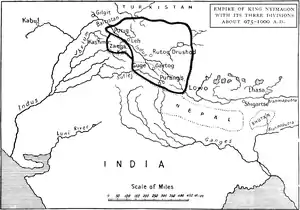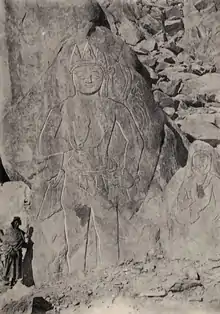Kyide Nyimagon
Kyide Nyimagon (died c. 930)[2] (Tibetan: སྐྱིད་ཨིདེ་ཉི་མ་མགོན, Wylie: skyid ide nyi ma mgon, THL: kyi idé nyi ma gön; Chinese: 吉德尼玛衮; pinyin: jídé nímǎgǔn), whose original name was Khri-skyid-lding, was a member of the Yarlung dynasty of Tibet and a descendant of emperor Langdarma, who founded the kingdom of Ngari Khorsum ("the three divisions of Ngari")[3] in Western Tibet around 912 CE. After his death, his large kingdom was divided among his three sons, giving rise to the three kingdoms of Maryul (Ladakh), Guge-Purang and Zanskar-Spiti.
| Kyide Nyimagon | |
|---|---|
 Empire of king Nyimagon in 975 | |
| Ngari Khorsum | |
| Maryul | |
| Successor | Lhachen Palgyigon |
| Guge-Purang | |
| Successor | Tashigön |
| Zanskar | |
| Successor | Detsukgön |
| Born | Khri-skyid-lding Lhasa |
| Died | c. 930 Tsaparang |
| Consort | 'K'or-skyon[1] |
| bo | སྐྱིད་ཨིདེ་ཉི་མ་མགོན |
| Father | Depal Khortsen |
Family
After the assassination of the emperor Langdarma, the Tibetan empire entered a period of civil war over succession by Langdarma's two sons Yumtän (Yum-brtan) and Ösung ('Odsrung), which divided the empire into two parts.[3][4] Ösung's son Depal Khortsen (c. 870–c. 910)[5] is believed to have controlled most or part of Central Tibet.[6]
Palgyigon was one of the sons of Depal Khortsen, the other being Trashi Tsentsän (bKraśis-brtsegs-brtsan).[1] Both the sons fled Ü-Tsang (Central Tibet) in 910 when their father was murdered, at the end of the 3rd revolt in Ü-Tsang, which is taken to mark the beginning of the Tibetan Era of Fragmentation.
Reign
Nyimagon established a kingdom in Ngari (Western Tibet), in or around 912. He annexed the kingdoms of Purang and Guge. He then established his capital in Guge.
The Sino-Tibetan culture came to replace the culture of Brokpa and Mons in present-day Ladakh, which had been present in the region for a long time.[2]
Succession
He gave Lhachen Palgyigon (Tibetan: དཔལ་གྱི་མགོན, Wylie: dpal gyi mgon), his elder son, the kingdom of Maryul (now known as Ladakh).[8] His other two sons, Tashigön (Tibetan: བཀྲ་སིས་མགོན, Wylie: bkra sis mgon), and Detsukgön (Tibetan: ལྡེ་གཙུག་མགོན, Wylie: lde gtsug mgon) received respectively Guge-Purang and Zanskar. These three countries together were called Ngari Korsum.[9][8]
He died around 930.[2]
Tashigön's son Yeshe-Ö, lama-king, who inherited from him Guge-Purang in 967,[10] abdicated in 975 and devoted himself to monastic life.
References
- Petech 1977, p. 15.
- Hāṇḍā 2001, p. 128.
- Ryavec 2015, p. 70.
- Schlichtmann, Klaus (2016), A Peace History of India: From Ashoka Maurya to Mahatma Gandhi, Vij Books India Pvt Ltd, p. 108, ISBN 978-93-85563-52-2
- McKay 2003, p. 57.
- Petech 1977, pp. 14–15.
- Francke, A. H. (1907). A History of Western Tibet: One of the Unknown Empires. S. W. Partridge & Co. (London). p. 63.
- Francke 1992, p. 94.
- Fisher, Rose & Huttenback 1963, p. 19.
- Hāṇḍā 2001, p. 209.
Bibliography
- Di Mattia, Marialaura (Summer 1996), "Historical Profile of Ladakhi Religious Architecture", The Tibet Journal, Library of Tibetan Works and Archives, 21 (2, Shaping the Mind: Artistic Facets of Tibetan Civilization): 90–127, JSTOR 43302279
- Fisher, Margaret W.; Rose, Leo E.; Huttenback, Robert A. (1963), Himalayan Battleground: Sino-Indian Rivalry in Ladakh, Praeger, doi:10.2307/40199339, hdl:2027/mdp.39015010426792, JSTOR 40199339
- Francke, August Hermann (1992) [1926], Antiquities of Indian Tibet, vol. 38, Volume 50 of New imperial series, Asian Educational Services, p. 94, ISBN 81-206-0769-4
- Francke, August Hermann (1907), A History of Western Tibet: One of the Unknown Empires, London: S.W. Partridge & Co
- Jahoda, Christian; Kalantari, Christiane (2015), "Kingship in Western Tibet in the 10th and 11th Centuries", Cahiers d'Extrême-Asie, École française d’Extrême-Orient, 24: 77–104, doi:10.3406/asie.2015.1315, JSTOR 24906071
- Hāṇḍā, Om Chanda (2001), Buddhist Western Himalaya: A Politico-Religious History, New Delhi: Indus Publishing, ISBN 978-81-7387-124-5
- McKay, Alex (2003), The History of Tibet, RoutledgeCurzon, ISBN 9780415308427
- Petech, Luciano (1977), The Kingdom of Ladakh, c. 950–1842 A.D. (PDF), Instituto Italiano Per il Medio ed Estremo Oriente – via academia.edu
- Ryavec, Karl E. (2015), A Historical Atlas of Tibet, University of Chicago Press, ISBN 978-0-226-24394-8
